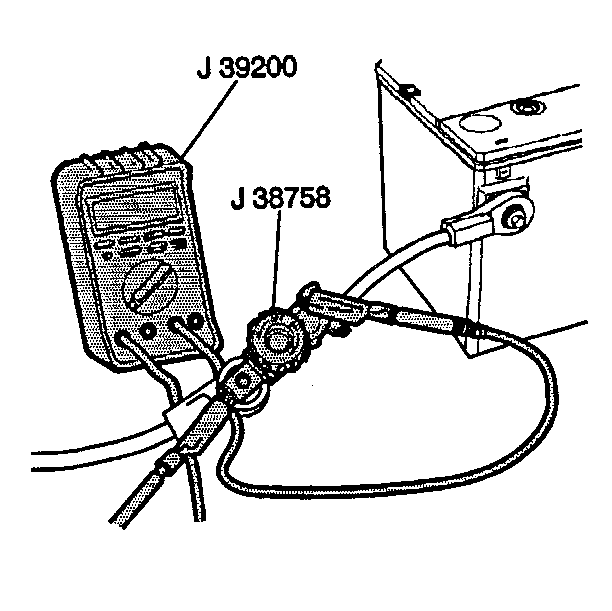Battery Electrical Drain
If the vehicle exhibits a low or dead battery after an overnight period,
or discharges over a period of 2 or 3 days, the electrical system should
be checked for an excessive electrical drain. This is referred to as Parasitic
Current Drain.
If a battery needs recharging and no cause is evident, check the vehicle
for excessive parasitic current drain.
One or more on-board solid state control modules, such as the PCM or
VCM, may at some time exhibit a failure mode that causes a high parasitic
drain on the vehicle's battery. When the battery is disconnected to install
an ammeter, etc., the excessive current drain may not occur once the circuit
continuity is restored. Even though cycling the ignition key to the RUN
and then to the OFF position may cause such a drain to recur, there may
be drains that will not recur unless the vehicle systems are reactivated
in a road test. Since the ignition switch must not be rotated to the ACCESSORY,
RUN or START position with an ammeter installed between the battery terminal
and the battery cable, a current drain test tool must be used as described
in the following procedures.
Before starting this procedure, ensure that the ignition switch is in
the LOCK position, all electrical accessories are turned OFF, the door glass
is open and the doors are closed.
Tools Required
| • | J 38758 Parasitic
Draw Test Switch Tool |
Caution: Unless directed otherwise, the ignition and start switch must be in the OFF or LOCK position, and all electrical loads must be OFF before servicing
any electrical component. Disconnect the negative battery cable to prevent an electrical spark should a tool or equipment come in contact with an exposed electrical terminal. Failure to follow these precautions may result in personal injury and/or damage to
the vehicle or its components.
Notice: Do not turn the parasitic draw test switch to the OFF position with
the engine running. Damage will occur to the vehicle's electrical system.
Notice: The test switch must be in the ON position when removing the fuses in
order to maintain continuity in the electrical system. This avoids damaging
the digital multimeter due to accidental overloading, such as
a door being opened to change a fuse.
- Disconnect the battery negative cable. Refer to
Battery Cable Replacement
in Engine Electrical.

- Install the male end
of the J 38758
to the battery
negative terminal.
- Turn OFF the test switch.
- Install the battery negative cable to the female end of the test
switch.
- Turn ON the test switch.
- Road test the vehicle while activating all accessories, including
the radio and the air conditioning.
- Turn OFF the ignition switch. Remove the key.
Important: From this point on, electrical continuity must be maintained in the
ground circuit of the battery through the J 38758
in the ON position or through the J 39200
.
- Components such as PCM and VCM have timers that draw several amps of
current while they cycle down. This can give a false parasitic drain reading.
Wait 15 minutes for these components to power down before continuing this
test.
- Set the J 39200
to
the 10 A scale.
Important: If an ammeter other than the J 39200
is used, ensure that the vehicle does not have a high current
drain that would damage the ammeter when connected to the circuit. This can
be done using the following procedure:
| 9.1. | Connect a jumper wire with an in-line 10 A fuse J 36169-A
to the terminals of the test switch. |
| 9.2. | Turn the test switch to the OFF position. |
| 9.4. | If the fuse does not blow, the current is less than 10 A
and the ammeter can be used safely. |
| 9.5. | Turn the test switch to the ON position before the fused jumper
wire is remove and the multimeter is installed. |
- Connect the ammeter to the test switch terminals.
- Turn OFF the test switch. This allows the current to flow through
the ammeter.
- Wait at least 60 seconds, then check the current reading.
| • | When there is a current reading of 2 A or less, turn ON
the test switch, this maintains continuity in the electrical system. |
| • | Then, switch the meter down to the 2 A scale, for a more
accurate reading, when the test switch is reopened. |
- Take the reading in milli-amps.
- Note the battery reserve capacity. Refer to
Battery Usage
.
| • | Divide this number by 4. |
| • | Compare this to the multimeter reading. |
| • | The current drain should not exceed this number. |
| • | Example: if a battery has a reserve capacity of 100 minutes, the
current drain should not exceed 25 milli-amps. If the vehicle has a
diesel engine with 2 batteries, add the reserve capacities together and divide
this total by four. |
Notice: Always turn the test switch knob to the ON position before removing
each fuse to maintain continuity in the electrical system and to avoid damaging
the meter due to accidental overloading, such as opening a door to change
a fuse.
- When the current draw is too high, remove the electrical system fuses
one at a time until the draw returns to a value less than or equal to specifications.
- Repeat the parasitic current drain test procedure
after any repair has been completed.
- When the cause of the excessive current draw has been located
and repaired, remove the meter and the parasitic draw test switch and terminal
adapters.
- Connect the negative cable to the battery negative terminal. Refer
to
Battery Cable Replacement
in Engine Electrical.

